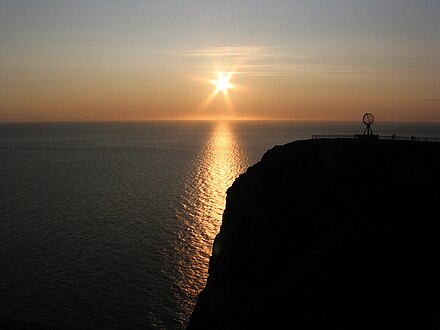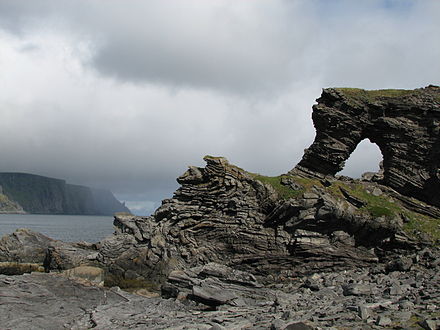Nordkapp - cape on the island of Magerøya in Northern Norway
Nordkapp (North Cape) is a 307-m-high (1007-ft) cliff rising above the Arctic Ocean, located in Finnmark county in Norway. It is the northernmost point in Europe reachable by car, and the northernmost place connected with the international road network. Some 200,000 tourists visit annually, during the two to three months of summer. Nordkapp is also the name of the municipality. The town Honningsvåg is the municipality's administrative centre, 34 km south of Nordkapp, 30 minutes' drive by car. It is where you'll find most services.
From October to April the road to Nordkapp is not open to ordinary traffic. December–January there is no real daylight as the sun remains under the horizon.
Understand

Nordkapp is promoted as the northernmost point of mainland Europe, which is not exactly true. Nordkapp is on an island, Magerøya, and the neighbouring point Knivskjellodden is actually 1,457 m (4780 ft) further north (on the same island). Nordkapp is however the northernmost point in Europe reachable by the international road network. Islands farther north, such as Novaya Zemlya, are far from the mainland. The northernmost point on the actual mainland (islands like Magerøya not included) is Kinnarodden some 25 km from Mehamn.
The midnight sun may be enjoyed 14 May–29 July, unless the night is cloudy.
Nordkapp – The North Cape, the North Cape Horn – has always been a well-known and important point of orientation for all boats and ships navigating the area. The rock has had a great variety of names and it was only in the mid 16th century that it was given the present name.
In 1553 an English commander, Richard Chancellor passed Nordkapp and named the cliff Nordkapp, the North Cape. From that time, it has been called Nordkapp. At that time it wasn't exactly the centre of interest. But only 100 years later, the first "tourist" was reported to have climbed up to the plateau. He was an Italian priest named Francesco Negri. It took him more than two years to go from Italy on foot, by boat, on horseback, on sleighs and on skis. In 1664, finally having reached his destination, he noted in his travel log: "Here I am now on the North cape, at the extreme tip of Finnmark, really at the end of the world"
In the 18th and 19th centuries, a journey to Nordkapp was still an adventure – and an expensive one at that. One needed to get a ship with crew or to arrange an expedition through hundreds of kilometres of wilderness. This is why there were quite a few high-ranking people among the first tourists: Prince Louise Phillippe of Orleans, Oscar the second, King of Norway and Sweden, King Chualalonkorn of Thailand. He got his name and date carved into a rock on the top of the plateau. This rock can be seen in the Panorama hall in front of the souvenir shop. And Kaiser Wilhelm II of Germany was here also.
In 1875, London Travel agent Thomas Cook organized the first group travel to Nordkapp for 24 participants. At that time travelling to Nordkapp was very different compared to how it is now. There was no road leading across the island to the plateau. Travellers were taken by rowing boat from Skarsvåg or Gjesvær to Hornvika, just below the north cape. From there they had to climb up the steep and rocky ravine, to reach heigh of plateau. The first modest wooden buildings started to appear on the plateau. One of those was the hut "Stoppenbrink's Champagne Pavilion.
Get in
In winter, the Nordkapp road is not open to ordinary traffic. Nordkapp is accessible only via a daily convoy headed by a snow plough. The day's convoy can be cancelled if there is severe weather. The visitor centre is open for approximately one and a half hours between the arrival of the convoy and its departure. Visitors have to return with the convoy.
By plane
- Honningsvåg Airport, Valan (IATA: HVG), 71.009722°, 25.983611°. Three daily departures from Tromsø with Widerøe. Both domestic and international connecting flights to Tromsø.
- Lakselv Airport, Banak (IATA: LKL, "North Cape Airport"). Five daily departures from Tromsø, two daily bus departures from Lakselv to Honningsvåg. This airport is classified as an international airport, and handles most of the travellers to Nordkapp arriving by plane. All regional flights are operated by Widerøe. International seasonal charter routes are operated by Condor, Spanair and SAS. 2019-03-24
- Alta Airport (IATA: ALF). The busiest airport in Finnmark. Multiple daily flights from Oslo, with Norwegian and SAS. 2019-03-24
By car
.jpg/440px-Nordkapp_-_panoramio_(8).jpg)
Nordkapp is where European route E69 ends. E69 branches off European route E6 at Olderfjord, 129 km (80 mi) away. The road passes several tunnels and the deep undersea North Cape Tunnel reaches 212 m below sea level at its lowest point. There used to be a toll, but since 29 June 2012 using the tunnel is free. The North Cape Tunnel has a continuous downwards and upwards slope of 9%. The road inside the tunnel has one lane in each direction, with a dedicated lane on each right side for cyclists. Select the correct gear before entering the slope. This is important, since there is no clear view of when the slope goes from downwards to upwards. Consider driving a car with an engine able to increase speed considerably when driving upwards.
By bus
There is a network of bus lines in Finnmark. For example there are two daily buses Alta–Honningsvåg. Search finnmark.no (dead link: August 2020)
It is possible to do it in a day trip from as far away as Karasjok, even in winter. Check the schedules and, if in winter, ensure you arrive in Honningsvåg before 11:30 and the return bus leaves no earlier than 14:50. You can buy tickets for the Nordkapp tour from the tourist office behind the Scandic Honningsvåg, or directly from the driver, which is a bit cheaper.
Connection from Rovaniemi and Helsinki, Finland is operated by Eskelisen Lapinlinjat.
By boat
Hurtigruten calls Honningsvåg. Several Cruise ships visit Honningsvåg and Nordkapp every year. It is possible to transport a car (not a camper car) on Hurtigruten. This is an interesting option to cut distances, for example if going to the Mehamn area, the northernmost mainland in Europe.
By bicycle
When arriving by bicycle, be aware of the tunnel from the mainland. This is a 7 km tube going 212m under the sea level. Good fun the first 3 km, and remember the speed limit. You'll need good gears to get out again. You will need them on the surface road too, from Honningsvåg to the North Cape plateau. Take care of the wind: gale of 7 or 8 Bf with gusts far stronger than that is not unusual. At the North Cape centre itself, don't forget to sign the cyclists' guest book.
Get around
In Honningsvåg city center and in the North Cape area itself one can get around by foot. Practically all traffic from and to the North Cape goes through Honningsvåg, 34 km or half an hour to the south by car or bus. Travelers from Northern Europe usually arrive with their own cars or camper, and many travellers from countries further away buy a package which includes the transport to and from the North Cape.
If you've simply bought a flight ticket to Honningsvåg airport, or using public buses, the only way to get to the North Cape itself aside from hitchhiking or hiking (only for the most adventurous, and bring your own tent as there is no accommodation whatsoever on the cape itself) is taking a taxi, or the local bus 330 (www.177finnmark.no (dead link: August 2020)), which runs a few times per day in the summer and not at all in the winter.
Hurtigruten charters special buses going to North Cape. Tickets are bought onboard. The ship stays several hours in Honningsvåg so there is time for such a trip.
See

- Kirkeporten (Church gate). A cliff with a hole trough, where the view towards Nordkapp can be enjoyed.
- Nordkapphallen. 1 May-17 May: 11:00-15:00, 18 May-31 Aug: 11:00-01:00. A big hall carved out in the plateau, where the view can be enjoyed. Adults: kr 235, students: kr 150, children: kr 80
- Nordkappmuseet, +47 48060465, nordkappmuseet@kystmuseene.no. 16 Aug-31 May: M-F 11:00-14:30. Telling the aspects of fishieries and everyday life, in the far north. Adults: kr 70, Seniors(65yrs): kr 60, Students: kr 50, Children(up to 17yrs): Free 2022-02-16
Do
- Birdsafari, Gjesvær (21 km (13 mi) from the junction at E69). See seabirds like puffins, and the birds' mountain.
- Knivsjellodden, 71.122°, 25.71°. Hike to Knivskjellodden. The track is marked with red T's. The distance is 8 km (5 mi), and the hike takes an estimated two and a half hours, each way. Since the weather is unstable at this high latitude, you should always leave a message detailing where you were going and what time you left in your car. For safety, bring a GPS and mark a waypoint at the parking place.
Buy
- Nordkapp Jul og Vinterhus, Skarsvåg, +47 78-47-52-89, post@julehuset.no. Christmas decoration and the Nordkapp Santa.
- Gallery West Of The Moon (Evart), Storgata 4A (2 min from the harbour, on the main street), 70.982129°, 25.971596°, +47 41-84-10-30, westofthemoon@evart.no. 10:30–16:00 daily for Hurtigruten in the winter. This gallery situated in the centre of Honningsvåg displays the work of Eva Schmutterer, an artist established in nearby Kamoyvaer. Her pictures of the North Cape island under every angle and every seasonal light make for a perfect souvenir of a trip to the North Cape. Many other decoratives available. 2018-07-31
Eat
- Corner Café, +47 78476340, post@corner.no.
- NOR Food and Drinks (NOR Mat og Drikke), Holmen 6B, 9750 Honningsvåg, Norway (Resturant is located near roundabout on the harbor), 70.9819°, 25.9698°, +47 948 18 373. M–Sa 11:00–24:00 Su 15:00–21:00. Features wheelchair ramp for access. Owner: Kooperativet Nordkapp AS. 2021-10-03
Drink
- Sjøgata pub (Perleporten Kulturhus), Sjøgata 20 (in walking distance to the hotels in Honningsvåg.), 70.979706°, 25.976904°. In order to access the pub you have to use a stair leading up from street, or slightly less inclined stairs from the street above. This could pose accessibility issues. 2021-10-03
Sleep
Budget
- Nordkapp Camping, Skipsfjorden (24 km from Nordkapp), +47 78-47-33-77, post@nordkappcamping.no. Tent: kr 150, Double: kr 650, Cabin: kr 595-635, Bed linen: kr 90
- Nordkapp Caravan & Camping, Skarsvåg (14 km from Nordkapp), +47 45-22-19-42, bjp3012@gmail.com.
Mid-range
- Nordkapp Arran Hotel, Kamøyvær (27 km from Nordkapp), +47 75-40-20-85, aina@arran.as.
- Rica Hotel Honningsvåg, Nordkappgata 4 (34 km from Nordkapp), +47 78-47-72-20, rica.hotel.honningsvaag@rica.no.
- Rica Hotel Nordkapp, Skipsfjorden (26 km from Nordkapp), +47 78-47-72-60, rica.hotel.nordkapp@rica.no.
- Northcape Lodge, Skarsvåg (14 km from Nordkapp), +47 90-74-21-22. House with five beds in two rooms. Access to the sea and the possibility to fish, or hiking in the mountain from the house. €163 2018-06-30
Connect
Go next
You can get out the same way you got in; by road, boat or plane. If you've arrived by car you can continue with the Hurtigruten ship if you want some break from the driving. This allows you to visit another peninsula or island without driving the long way around the fjords.
Nordkapp
2nd-order administrative division
Troms og Finnmark
Primary administrative division

